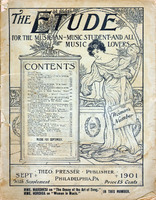Until within a few years the position of organist and choir-director in the more prominent city churches has been closed to women. They frequently have held the position of organist in the smaller churches, and many of the country churches, large and small, have had women as organists, but the music committees of the larger city churches would not engage a woman as organist. Her technical capability was not questioned; she was a woman, and that was sufficient.
Now, however, we find many women holding prominent positions, and many women are doing excellent concert work. Undoubtedly, up to a certain point, women make just as good organists as men—many of them surpass their brother-organists, but the proportion of women holding the most desirable positions as compared with men is still small.
In organ-playing, modern organs and modern methods have eliminated the old question of physical strength. Women develop digital dexterity even more rapidly than men. Their keen perceptive faculties aid them in acquiring an insight into the principles of effective registration. Pedal technic of the ordinary style comes easy to them. While they are studying they apply themselves closely to their task. In short, with the same conditions as to hours of practice, freedom from outside interruption, and continuation of study, the majority of women will surpass the men.
Nevertheless, very few women attain the pinnacles of success as virtuosi, not because they are incapable, but because they generally abandon the chase before the game is won, either from force of circumstances (marriage, exhaustion of funds, or illness in the family requiring their care, etc.) or from a sense of self-satisfaction at the height already attained. Many women have made excellent pianists. Madame Schumann and Madame Essipoff, not to mention others, have ranked very high, but far below Liszt, Rubinstein, Paderewski, de Pachmann, Joseffy, and a host of others. Likewise many women have become remarkably fine organists; but where do we find a female Guilmant, Best, or Widor?
Just as a man may be an ideal choir-director for a quartet choir or for a small chorus, and, yet prove a failure as a conductor of a choral body of a hundred or more singers, likewise may a woman be an excellent organist for church work and “church organ-recitals” who would leave much to be desired when appearing as a virtuoso in the concert-hall.
A large four-manual concert-organ is a masculine instrument, not because it has a pedal keyboard, but because its treatment must range from the most delicate and sympathetic to the boldest, grandest, and most majestic, requiring the widest angle lens in producing its tonal pictures and demanding the same combination of gentleness, firmness, boldness, and an instantaneous grasping of situations which is necessary in driving four spirited horses through the crowded city streets.
Notwithstanding this masculinity of a large concert-organ, some women are rapidly acquiring a more complete control of the instrument, and their concert- work each season is proving that the possibilities of development in women are nowhere near exhausted. The day may not be far distant when we shall have a group of three organists of the gentler sex ranking with Guilmant, Best, and Widor.—Everett E. Truette.



